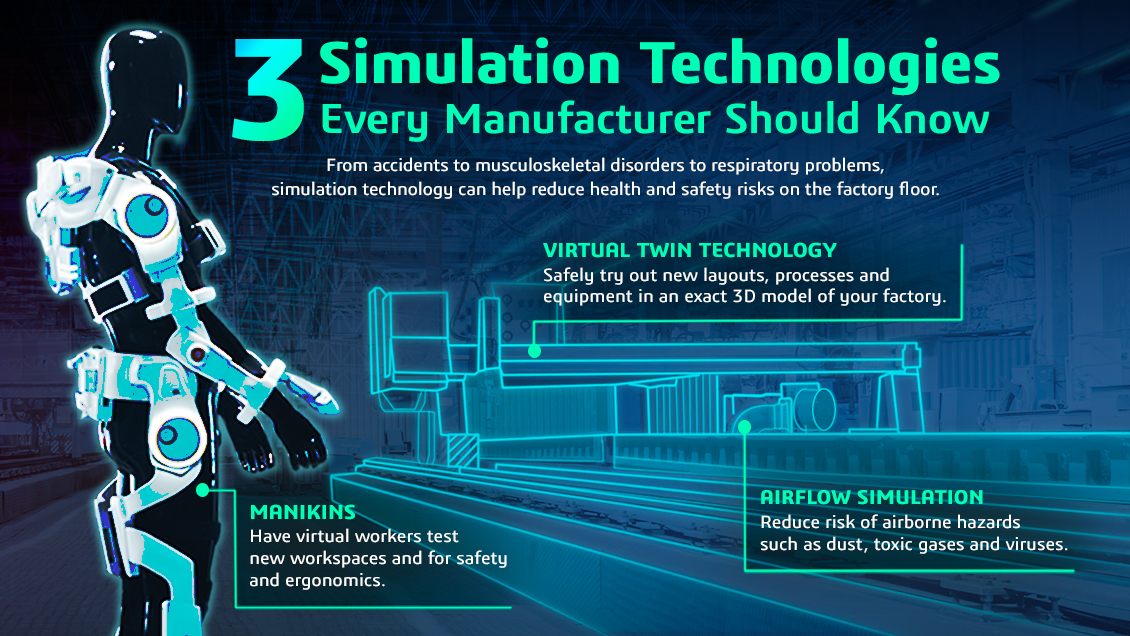Improve Manufacturing Safety with Simulation Technology
With a cloud-based collaborative simulation platform, manufacturers can "see" how changes impact worker safety and then implement the best solutions to achieve health and safety goals.
Despite a long-held commitment to injury prevention in the manufacturing industry, health and safety remains achallenge. In the UK, manufacturing sees an average of 66,000 non-fatal injuries per year. Nearly half of these are due to slips, trips or falls (23 percent) and lifting and carrying (22 percent), and 35,000 of the country’s manufacturing workers suffer from new or long-standing musculoskeletal disorders. In the US, manufacturing accounts for 15 percent of non-fatal injuries or illnesses.
Simulation: The Fastest Route to Health and Safety
Manufacturers have long used simulation to make better products, improve processes and get the most out of capital expenditure. Now, more and more manufacturers are also leveraging simulation technology to protect their workers against illnesses and injuries. In a virtual environment, equipment is tested, factories are built and plant layout is determined. If there are potential hazards, they are identified and addressed to ensure the real-life versions pose no danger to workers.
“You don’t want to use a real-world system to test worker safety and risk anybody getting sick or hurt,” says John Eskuri, Senior Director of the DELMIA Industrial Engineering Portfolio at Dassault Systèmes

Safety is the Sum of its Parts
There is no single dimension to safety on the factory floor. Safe equipment can be dangerous to a careless user. Conversely, no amount of safety training will protect workers in an inherently unsafe environment.
Advanced simulation technology empowers manufacturers to approach safety initiatives from all sides. A factory’s virtual twin is an accurate and highly detailed representation of its layout, equipment and processes. Machines and even people can be placed in and interact with the virtual factory. This allows manufacturers to run scenarios and answer questions like:
- How will plant safety be affected if we add a robot between two humans in this production line?
- What if a worker of above-average height spends four hours at a time at this workstation?
- What changes do we need to make to protect our workers from exposure to COVID-19?
“It has been a huge benefit to be able to use 3D virtual twins of factory assembly lines; to be able to simulate different configurations to find the optimal solution for this new world,” explains John.
One Platform for Every Dimension
Simulation in manufacturing is at its most effective when it is a collaborative effort. The cloud-based 3DEXPERIENCE® platform enables diverse, globally distributed stakeholders to work together to solve manufacturing’s many challenges, including worker safety.
The payoff of such collaborative work has been demonstrated by such initiatives as MyHea lth@Work. Here, Dassault Systèmes, manufacturers andtheir insurers can combine their knowledge and leverage simulation to achieve three outcomes:
Visualize
First, a high-resolution 3D scan is performed using lasers and cameras to quickly create a virtual twin of the factory.
Analyze
Next, within this virtual model, various scenarios are simulated. For example, changes are made to equipment, layout and parameters, and each scenario is assessed according to impact on worker safety.
Prevent
Stakeholders work together on the cloud-based MyHealth@Work dashboard to review recommendations and implement the changes necessary to improve plant safety.
Today’s factory floor is a much safer place than it has been in the past, but there is still a way to go. Increasingly, manufacturers who prioritize worker health and safety are turning to simulation technology as the best and fastest way to achieve their goal.
The Real-Life Benefits of Simulating a Safe Working Environment
Discover in more detail the many innovative ways simulation technology helps manufacturers improve their workers’ safety, processes, and assets.
Read our top articles on Operational Optimization
Explore our Industry Solution Experiences
Learn more about how our industry solutions can help you to achieve your professional ambition and business objectives